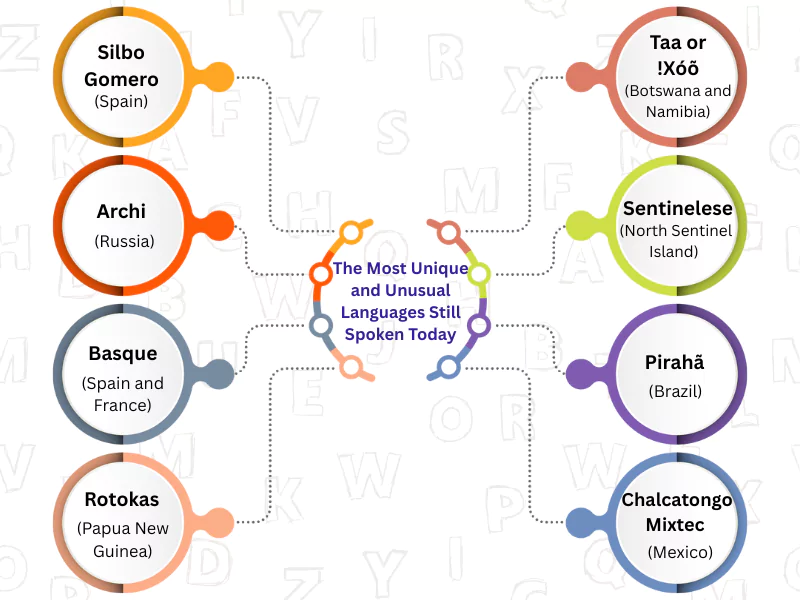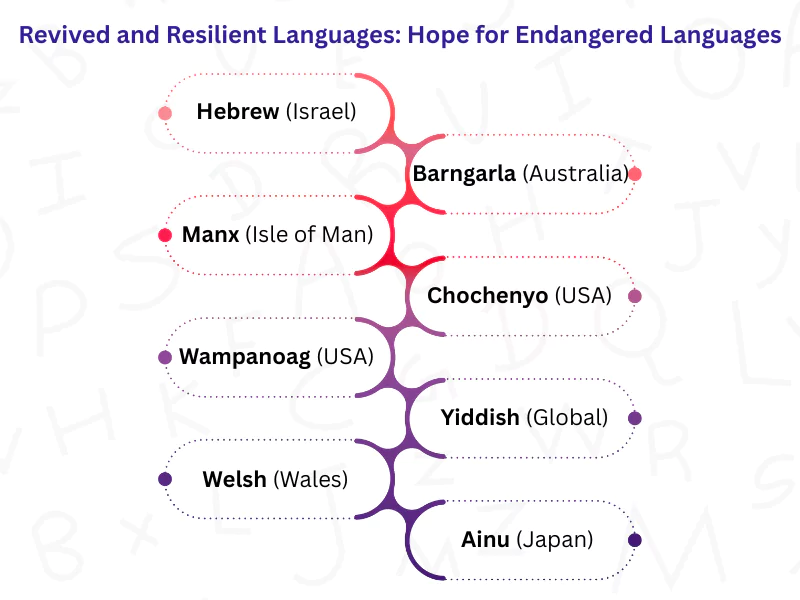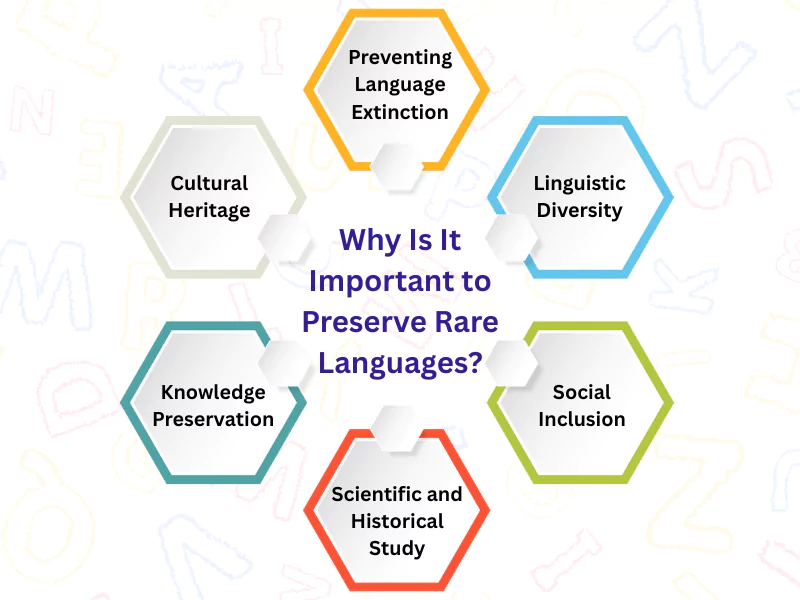From the most common languages like English with 1.53 billion speakers, Chinese with 1.3 billion speakers, and Hindi with more than 609.1 million speakers, to the least spoken languages in the world like N|uu, Taushiro, Tanema, Kaixana, and Paraujano with a cumulative of 4 speakers, we speak more than 7000 languages every day in the world. Furthermore, some languages are no more than whistles.
So, does it ever occur to you what the most unknown language in the world is? If so, then you’re in for a rollercoaster ride because today we will talk about the most uncommon languages, some of which might be going extinct in a day or two!
Table of Contents
Toggle20+ Rare Languages: The Fascinating World of "Unknown" Languages
Today, the younger generation, known as Gen Z and Alpha, converses in a language that many people struggle to understand. The language is too complex because one word can have multiple meanings depending on the context, which many fail to comprehend.
For instance, the word “Skibidi” can mean from “cool” or “good” to “bad,” “weird,” or even “nothing at all.”
As linguists, we find it fascinating because the generation concentrates on conveying their emotions and feelings, breaking the norms of words and phrases, or letters that might sometimes fail to convey emotions.
Interestingly, the concept of rarity is re-established, and while we have some dominant languages, concepts like cultural heritage and linguistic diversity make the world a place where most languages intermingle to create something new, giving birth to new languages which sometimes survive the blows of time and sometimes do not.
For instance, Njerep formed as part of the Mambiloid linguistic sphere on the Cameroon-Nigeria border, representing the cultural significance of a small ethnic group that has nearly vanished due to historical migrations, external pressures, and language shift to more dominant tongues, including Mambila, French, and Fulfulde.
But Njerep is not the only one, here’s a list of the most unique languages, their history, and language family or type:
| Language | How It Came Into Being / History | Language Family / Type |
| Kaixana (Brazil) | Spoken by a small indigenous community in the Amazon; minimal written history; likely existed for centuries in the Amazon basin. | Language isolate (classification unclear). |
| Taushiro (Peru) | Developed among the Taushiro tribe along the Tigre River in Peru, an oral tradition predating colonial times. | Language isolate. |
| Tanema (Solomon Islands) | Spoken by inhabitants of Vanikoro Island; related to nearby Polynesian/Melanesian languages. | Austronesian |
| Lemerig (Vanuatu) | Indigenous to Vanua Lava in Vanuatu, dwindled with the community shift to other local languages. | Oceanic (Austronesian branch). |
| Chamicuro (Peru) | An indigenous language of the Chamicuro people in the Peruvian Amazon. | Arawakan family. |
| Ongota (Ethiopia) | Spoken by the Ongota community along the west bank of the Weito River, one of Africa’s most mysterious languages. | Isolated Language or Afro-Asiatic (debated). |
| Njerep (Cameroon) | Used by the Njerep ethnic group in Cameroon and Nigeria, facing extinction as the community shifts to Mambila. | Mambiloid (Niger–Congo family) |
| N|uu | The San people, who were southern Africa’s first hunter-gatherers, have around 112 distinct sounds, with 45 clicks. | Spoken by a small group of San people, it is considered one of the oldest languages in southern Africa. |
| Haida (Canada) | The traditional language of the Haida people on Haida Gwaii is distinct and ancient. | Language isolate (formerly thought to be Na-Dene). |
| Silbo Gomero (Spain) | Developed for long-distance whistled communication on La Gomera (Canary Islands). | Whistled form of Spanish (Derives structure from Spanish). |
| Archi (Russia) | Ancient village language spoken in Dagestan; highly complex verb system. | Northeast Caucasian family (Lezgic branch). |
| Pirahã (Brazil) | Developed by the Pirahã people along the Maici River of the Amazon, notable for their unique grammar and culture. | Mura family. |
| Rotokas (Papua New Guinea) | The Indigenous language developed on Bougainville Island is renowned for its simplicity. | East Bougainville (Papuan languages). |
| Taa/!Xóõ (Botswana, Namibia) | Used by San peoples; characterised by clicks; possibly one of Earth’s oldest languages. | Tuu language family. |
| Sentinelese (North Sentinel Island) | Language of the uncontacted Sentinelese tribe; no external knowledge due to their isolation. | Unclassified; total isolate |
| Basque (Spain, France) | Pre-Indo-European language of the Basques; spoken for thousands of years in the Pyrenees. | Language isolate (Euskara). |
| Chalcatongo Mixtec (Mexico) | The ancient Oto-Manguean language, spoken in Oaxaca, has changed as speakers have intermixed with other groups. | Oto-Manguean (Mixtecan branch). |
| Hebrew (Israel) | An ancient Semitic language, it went extinct as a native tongue but was revived in the late 19th–20th centuries. | Afro-Asiatic (Semitic) |
| Manx (Isle of Man) | The Celtic language of the Isle of Man; revived from the last native speakers and archival recordings. | Indo-European (Celtic, Goidelic) |
| Wampanoag (USA) | The Algonquian language of indigenous people in Massachusetts; revived from written records. | Algonquian (Eastern Algonquian family) |
| Barngarla (Australia) | Language of the Barngarla people of South Australia; revival based on 19th-century documentation. | Pama–Nyungan (Thura-Yura subgroup) |
| Welsh (Wales) | The ancient Brythonic Celtic language, indigenous to Wales, has survived due to its resilience and effective policy. | Indo-European (Celtic, Brythonic) |
| Chochenyo (USA) | Language of the Muwekma Ohlone in California; revitalised after being dormant for over 70 years. | Utian (Yok-Utian family) |
| Yiddish (Global) | Developed among Ashkenazi Jews in Central Europe; it combines German, Hebrew, and Slavic roots; revival through culture and education. | Indo-European (Germanic, High German) |
| Ainu (Japan) | Indigenous language of Hokkaido; nearly lost, now being revived by new generations. | Language isolate |
The "Loneliest" Languages: A Look at Critically Endangered Languages

Many languages are considered critically endangered, with only a handful of speakers left. Here are some of the least spoken tongues on the planet.
Kaixana (Brazil): The World’s Least Spoken Language?
According to recent reports, there is only one known speaker of this Amazonian language, potentially making it the least spoken language.
Taushiro (Peru): A Language Isolate on the Verge of Disappearing
This is a language isolate with only one remaining fluent speaker. The weight of this linguistic world rests on the shoulders of one man: Amadeo García García. Living in the Peruvian Amazon, he is the last fluent speaker of Taushiro, carrying the complete cultural history, stories, and unique worldview of his ancestors. His passing will mark the final extinction of the language, a poignant reminder of the human cost of language loss.
Tanema (Solomon Islands): A Language Facing Imminent Extinction
This language is also considered to have only one speaker left.
Lemerig (Vanuatu): A Critically Endangered Language of the Pacific
Only a couple of speakers of this language remain on the Pacific island.
Chamicuro (Peru): A Language with Fading Memories
While likely extinct, there may be a few elderly individuals who remember some of the language.
Ongota (Ethiopia): An Almost Extinct Afro-Asiatic Language
Fewer than 10 speakers of this language are left.
Njerep (Cameroon): An Obscure Language on the Edge of Silence
Spoken in Cameroon, Njerep is one of the world’s most critically endangered languages, with only a handful of elderly speakers remaining.
N|uu (South Africa): A Unique Language with Ancient Roots
This language, with its unique click sounds, has fewer than five remaining speakers.
Haida (Canada): A Language Fighting for Survival
Once spoken by thousands, there are now only about 20 speakers of this critically endangered language.
The Most Unique and Unusual Languages Still Spoken Today

Beyond the number of speakers, some of the most obscure languages are fascinating due to their unique structures and characteristics.
Silbo Gomero (Spain): A Whistled Spoken Language
Spoken on the Canary Islands, this is a language composed entirely of whistling, developed to communicate over long distances. This incredible language allows islanders to “speak” across deep ravines and valleys, with messages travelling up to 5 kilometres. It isn’t a separate language but a whistled form of Spanish, where different whistle frequencies and lengths represent specific vowels and consonants. Now protected as a UNESCO Intangible Cultural Heritage of Humanity, it is taught in schools on La Gomera to ensure this living tradition is never lost.
Archi (Russia): A Language of Immense Complexity
Apart from being the hardest language to learn, Russian, spoken in a few villages in Dagestan, is famous for its massive number of verb conjugations—a single verb can have over 1.5 million forms. The complexity of Archi is almost beyond belief. The figure of 1,580,202 possible forms from a single verb root is not an exaggeration. This is because the verb’s form changes to reflect tense, mood, and evidence (e.g., distinguishing between something you saw yourself versus something you were told happened). This makes it a fascinating puzzle for linguists and one of the most grammatically intricate languages on Earth.
Pirahã (Brazil): A Minimalist and Unique Language
This Amazonian language has a minimal number of sounds (phonemes) and lacks words for colours or numbers, instead using “light” and “dark” or “few” and “many”. Beyond its minimalism, Pirahã has sparked a fierce debate among linguists. Researcher Daniel Everett claims the language lacks recursion—the ability to embed phrases within others (e.g., “the man who saw the dog ran away”). This directly challenges Noam Chomsky’s influential theory of universal grammar, making pirahã language one of the most important and controversial languages studied today.
Rotokas (Papua New Guinea): The Language with the Smallest Alphabet
This language holds the record for the smallest alphabet with only 12 letters and 12 phonemes.
Taa or !Xóõ (Botswana and Namibia): A Language of Clicks
In contrast to Rotokas, Taa is one of the most complex languages, with over 100 phonemes, including a large number of click sounds.
Sentinelese (North Sentinel Island): The Ultimate Obscure Language
Very little is known about this language because the Sentinelese people are uncontacted and hostile to outsiders, making it one of the most mysterious languages in the world. Sentinelese is the ultimate linguistic mystery. Because the Sentinelese people have remained isolated from the outside world, fiercely resisting all contact, not a single word of their language has ever been recorded or analysed. It is a true language isolate, not by classification, but by circumstance, making it the most unknown language on the planet in the most literal sense.
Basque (Spain and France): A True Language Isolate
Known as Euskara, this language is a complete isolate, unrelated to any other known language family worldwide.
Chalcatongo Mixtec (Mexico): A Language Without Questions
A peculiar feature of this language is that it has no way to distinguish between questions and statements grammatically.
Revived and Resilient Languages: Hope for Endangered Languages

Despite the existence of many endangered languages, language learning and preservation efforts are bringing some back from the brink.
Hebrew (Israel): The Most Successful Language Revival
Once extinct as a daily spoken language, Hebrew was successfully revived and is now the official language of Israel, spoken by millions.
Manx (Isle of Man): A Celtic Language Reborn
After being declared extinct in 1974, the Manx language has been revived through activism and is now taught in schools.
Wampanoag (USA): A Native American Language Revival
This is the first Native American language in the United States to be revived, with new generations now being brought up speaking it. The story of the Wampanoag’s revival is one of incredible determination. Linguist Jessie Little Doe Baird painstakingly pieced the language back together from historical documents, most notably a 17th-century Bible written in the Wampanoag language. Through the Wampanoag Language Reclamation Project, which she founded, a new generation is now being raised speaking their ancestral tongue, a powerful victory against cultural extinction.
Barngarla (Australia): An Aboriginal Language Reawakened
An Aboriginal language from South Australia that is being revived by the Barngarla community based on 170-year-old documents. The reawakening of Barngarla is a remarkable story of linguistic justice from South Australia. After lying dormant for over 50 years, the language is being brought back from the brink by the Barngarla community in close collaboration with linguist Ghil’ad Zuckermann. Their revival is built upon a precious foundation: a 170-year-old dictionary compiled by a German missionary in the 1840s. Using this vital historical record, the project has developed modern tools, including a mobile app, to put the Barngarla language back into the hands—and mouths—of its people, re-establishing a powerful link to their cultural heritage and identity.
Welsh (Wales): A Resurgence of a Celtic Tongue
Through significant government support and community efforts, the Welsh language has seen a major resurgence.
Chochenyo (USA): Revitalising an Indigenous Californian Language
The Muwekma Ohlone Tribe in California has been actively revitalising its language, which was last spoken in the 1930s.
Yiddish (Global): A Cultural Language Re-emerges
Once on the verge of being lost, Yiddish is now experiencing a revival through academic programs and cultural initiatives.
Ainu (Japan): An Indigenous Language of Japan Gets a New Voice
Indigenous to Hokkaido, the Ainu language is being revived through media and educational programs.
With this, we come to the most essential point of this hour: Language Preservation!
Why Is It Important to Preserve Rare Languages?

Preserving rare and endangered languages among the world’s languages is crucial for several key reasons:
- Cultural Heritage: Language carries a community’s history and wisdom. For even the world’s rarest tongues, this heritage is lost forever when a language is no longer heard spoken. When a community stops speaking the language of its ancestors, a unique cultural identity disappears. Preserving these traditions ensures they remain alive for future generations.
- Linguistic Diversity: Each language represents a unique way of thinking. The sheer variety of languages worldwide enriches human knowledge, fostering different perspectives and creativity that would be lost with linguistic uniformity.
- Knowledge Preservation: Many languages contain invaluable indigenous knowledge about local environments. Specialised wisdom, like that which might be found only in a specific dialect of the Mura languages, such as Pirahã, can be lost forever when a language vanishes.
- Social Inclusion: Protecting languages supports marginalised communities who are often pressured by the speakers of more dominant neighbouring languages. It gives them a voice, dignity, and recognition, promoting respect for their linguistic human rights.
- Scientific and Historical Study: Linguists, anthropologists, and historians study languages around the world to gain a deeper understanding of human history, cognition, and social evolution. Each language is a vital piece of that puzzle.
- Preventing Language Extinction: A nearly extinct language disappears forever roughly every two weeks. While thousands of vibrant languages are still spoken today, nearly half are at risk. Preserving them is akin to saving endangered species that are essential to global biodiversity.
Thus, safeguarding language diversity is integral to sustaining cultural richness, human knowledge, and social justice worldwide. Preserving these languages often requires meticulous documentation and translation. If you’re working on a project that requires expert handling of rare or complex languages, see how our specialised language translation services can help.
Conclusion: The Future of Our World's Spoken Languages
While a few widely spoken languages dominate global communication, our journey has illuminated the fragility of thousands more that are nearly extinct. Without intervention, these tongues are destined to join the long list of extinct languages, taking their unique cultural wisdom with them. This is why the mission to preserve endangered languages is more than an academic exercise; it is a vital act of cultural rescue. By supporting the communities behind these voices, we help keep the language alive and ensure that even a language that is not widely spoken can still have its story told for generations to come.
Frequently Asked Questions
What Is the Most Unusual Language in the World?
Many consider Silbo Gomero, the whistled language of the Canary Islands, to be the most unusual. Others point to the complexity of Archi or the isolation of the Sentinelese.
How Many Languages Are Spoken in the World?
There are over 7,000 languages spoken in the world today, but this number is decreasing as many languages are endangered and becoming extinct.
What Is the Rarest Language Still Spoken?
Languages like Kaixana, Taushiro, and Tanema are considered the rarest, with only one known speaker each. The least spoken language is a difficult title to assign definitively, as speaker numbers can be hard to verify, but this is certainly one of the rarest.
What Is the Oldest Forgotten Language?
Ancient languages like Sumerian and Akkadian are among the oldest languages in the world that are no longer spoken.
Can a Dead Language Be Revived?
Yes. The successful revival of Hebrew and ongoing efforts for languages like Manx and Wampanoag show that efforts to document and revitalise the language with community dedication can bring a language back into daily use. As a result, the language is still spoken by new generations.
- 10 Essential Tips for Your Financial Translations to Ensure Accuracy - September 10, 2025
- Which Are the Most Spoken Languages in the World: The Power Players - September 2, 2025
- Beyond English: What Is the Most Unknown Language in the World? - August 25, 2025





